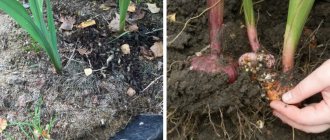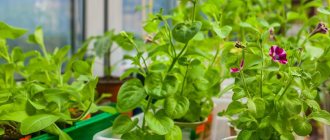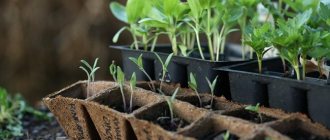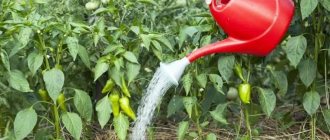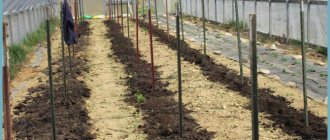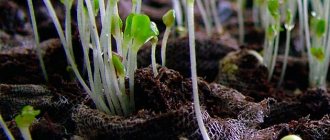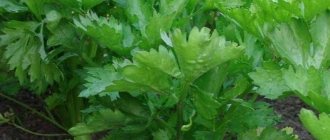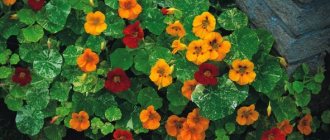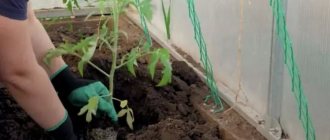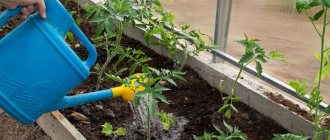Petunia is a colorful and showy flower, popular among both novice gardeners and professional landscape designers. With proper care, it can decorate any garden, becoming its bright accent. Many gardeners try to grow petunia seedlings on their own, because this is the only way to get a strong and flowering plant. When caring for seedlings, proper picking is very important to ensure healthy seedlings ready for transplanting into a flower bed or flower pot.
What is picking and why is it needed?
Picking seedlings is transplanting them from a common container into separate containers while simultaneously pinching the roots of the sprouts. Most often, pinching is done 2/3 of the length of the spine. This procedure is necessary so that the roots of the sprouts can fully develop, receive a sufficient amount of nutrients and increase green mass.
Picking has a positive effect on seedlings:
- stopping the growth of seedlings if they have outgrown;
- removal of weakened, thin and frail sprouts;
- acceleration of the growth of the root system, thanks to the accelerated growth of lateral leaves and stems.
Picking not only stimulates the growth of the root system, but also increases the resistance of seedlings to negative weather conditions, diseases and pests.
Without picking, the growing roots of petunia seedlings will lack nutrients, being in cramped conditions. Growing seedlings block each other's sunlight and begin to stretch upward, becoming thinner and weaker.
The roots of the seedlings also suffer, as they have catastrophically little room to grow. It is these problems that picking petunia seedlings is designed to solve.
Too late
Some gardeners, on the contrary, are afraid to approach tomatoes even in the phase of the first true leaves.
It seems to them that the plants are not yet strong enough, and they postpone replanting to a later date. But the more time passes after the “ideal” moment for picking, the more stress the plants will have to endure during this procedure. In cramped conditions, tomatoes begin to become depressed and stretch out greatly. In a cramped box, seedlings begin to stretch out and get sick, becoming more vulnerable to any unfavorable factors. In the small volume of the earthen coma, their root system is intertwined, and therefore receives severe injuries during transplantation. Such wounded poor things take much longer to take root in a new container, lag behind in development and, as a result, begin to bear fruit later.
Timing for picking petunia
To ensure that picking does not cause harm to the roots of petunia seedlings and does not injure them, it is necessary to take into account the appropriate timing for its implementation.
Determination of dive timing:
- picking at the stage of 3-4 true leaves is considered the best option;
- at least 25-30 days must pass from the moment of sowing the seeds;
- if the specified dates have not arrived, but the seedlings have sprouted very densely, they can be planted at the cotyledon leaf stage.
In case of slow growth of petunia seedlings or sowing of granulated seeds, the picking time can be shifted until 3-4 healthy true leaves are formed.
It is very important not to miss the right time and plant the sprouts in separate containers in a timely manner, otherwise the seedlings may stretch out, weaken and wither due to the growth of the root system and excessive thickening.
When to dive a bow according to the lunar calendar
When choosing a picking date, first of all, you need to focus on the readiness of your seedlings, but some days will be especially favorable for such work.
Picking a bow in 2022 according to the lunar calendar, favorable days
In March, favorable days will be 4, 5, 6, 7, 8, 9, 10, 11, 12, 13, 14, 15, 16, 17. The last two days are most suitable for the procedure.
In April, favorable days will be 3, 4, 5, 6, 7, 8, 9, 10, 11, 12, 13, 14. The last two days are most suitable for the procedure.
When is it not worth diving the bow in 2022 according to the lunar calendar?
In March, unfavorable days will be 1, 2, 3, 17, 18, 27, 28, 29, 30, 31.
In April, unfavorable days will be 1, 2, 15, 16, 17, 23, 24, 25, 26, 27, 29, 30.
Preparing for a pick
Before picking, you need to take care of the seedlings. Proper preparation will help reduce the stress of transplanting to a new place and quickly take root in another container.
Basic rules for preparing petunia seedlings for diving:
- Be sure to check the number of true leaves - if there are less than 3, then you need to wait a little while planting the petunia.
- For picking, you need to prepare nutritious soil - you can use a ready-made substrate for flower crops, sold in gardening stores.
- Water the petunia seedlings generously. The soil in which the young shoots are located must be moist.
- Carefully remove the petunia sprouts from the soil.
- Dip its root system in a weak solution of potassium permanganate.
Disinfection of roots is a mandatory stage in preparing petunia seedlings for further picking. It prevents the development of pathogenic microorganisms that can cause petunia diseases. Disinfection is carried out immediately before separating the seedlings into different containers.
Step-by-step instructions for picking petunia seedlings
Picking petunia seedlings is a simple and concise process that does not cause difficulties even for novice gardeners. First of all, to prepare seedlings you need to select containers. These can be peat tablets or cassettes, plastic or peat cups, small seedling boxes.
Step-by-step diagram for picking petunia:
- Spray the soil in the container with the sprouts using a spray bottle.
- Pour the prepared nutrient substrate into separate containers.
- Make a small indentation in the center of a glass or other container with a pencil and pour in water. By pre-moistening the soil, the roots of the seedlings will take root much faster.
- Carefully remove the seedlings from the box with moistened soil. To do this, you can use a toothpick, fork or small spatula. The sprouts must be removed very carefully, trying not to damage the root system. To be safe, it is best to retreat 5-7 mm from the seedling.
- Transfer the seedling and lower it into a separate container with nutrient soil mixture.
- Gently sprinkle the root system of the seedling with soil mixture, lightly press it and moisten it with a spray bottle.
- Additionally, you can spray the seedlings with a solution of Epin (2 drops per 100 ml). This growth stimulator will speed up the rooting of sprouts in a new location and reduce the stress of replanting.
When performing a dive, you need to act very carefully and carefully; sudden movements can harm fragile seedlings. It is best to pick up thin and weak shoots only by the leaf - even if you damage it, it will not cause any harm to the growth point.
Answers to frequently asked questions
Is it possible to treat seedlings against pests before picking, if there were any in the old soil?
Before picking, the roots of the seedlings can be lightly washed with a weak potassium permanganate solution so as not to transfer pests to a new habitat.
How soon can you fertilize after picking onions?
Replanting is stressful for any plant. For this reason, it is recommended to give the seedlings time to get used to it, and after 3-5 days, feed it.
Is there a chance for weak shoots to get stronger after picking?
Each case is unique, so an accurate answer to this question can only be obtained through experience. The chances of this are really small, but if opportunities allow, then you can give the frail seedlings a chance and pick them up along with the rest.
Caring for seedlings after diving
In order for petunia seedlings to take root well and quickly take root in a new container, they need to be provided with careful care and comfortable conditions created.
The main stages of caring for seedlings:
- watering;
- lighting;
- temperature;
- feeding;
- topping;
- hardening
Watering
Watering is very important for strengthening petunia seedlings; it helps the root system adapt to new growing conditions. The soil in the container should not dry out, but you should also not allow it to become waterlogged. When moisture stagnates, the root system of petunia begins to rot and the plant may die.
Temperature and lighting
When creating comfortable conditions for seedlings, you need to take care of its lighting and the correct temperature conditions. Petunia grows best at a temperature of +18-23°C.
You need to carefully monitor the condition of the seedlings - if they begin to stretch upward, this indicates an increased temperature. In such cases, containers with petunias should be moved to a cooler room overnight.
Petunia seedlings require plenty of sunlight. The optimal length of daylight is at least 12-14 hours. If necessary, you can use additional lighting sources.
Top dressing
7-10 days after picking, you can carry out the first feeding of the transplanted seedlings. As soon as 4-5 leaves appear on the sprouts, they are ready for fertilizer. It is best to use complex mineral compositions containing nitrogen, phosphorus and potassium.
Fertilizers for indoor plants can be bought at any gardening store:
- Crystallon;
- Uniflor;
- Ideal;
- Kemira Lux or Universal.
If petunia seedlings begin to stretch, they can be sprayed with a solution of calcium nitrate. If it becomes pale and loses its rich color, this is a common sign of iron deficiency. In such cases, fertilizing with Ferovit, Micro Fe or iron chelate is used.
After re-transplantation, the seedlings are fed with granulated nitrophoska. To do this, 1-2 granules need to be deepened near the wall of the container - this will prevent burns to the root system of the petunia.
To fertilize petunia seedlings, you can also use organic fertilizers. Wood ash is excellent for this purpose, as it will restore the balance of phosphorus and potassium and strengthen the plant’s resistance to bacteria and pests.
Wood ash can be used in two ways - simply scatter it on the soil surface or prepare a solution of 2 liters of clean, settled water and 150 grams of ash.
For a complete overview of the products, see the article: “What and how to feed petunia seedlings.”
Topping
The first picking of petunia seedlings is most often carried out without pinching. This is done during re-transplantation, which is carried out after 25-30 days.
To do this, remove the top part of the plant with two leaves. It is most convenient to pinch with disinfected nail scissors or stationery scissors.
Repeated picking is no less important than the first transplant. Petunia sprouts are planted in small containers, which soon become too small for them due to the rapid growth of the root system. Since there is still a lot of time left before planting flowers in open ground, the plant is picked again.
The second picking of seedlings is carried out using the transshipment method:
- Spray the soil in a box or cup with a petunia sprout from a spray bottle - this will make it easier to remove it.
- Separately, prepare large boxes or containers with drainage holes. If they are not in the container, do it yourself.
- Fill the bottom of the container with drainage - pebbles, expanded clay, vermiculite. The thickness of the drainage layer must be at least 1 cm.
- Pour nutrient substrate on top of the drainage, filling the container about 2/3 full.
- Carefully remove the sprout from the container and pinch it , holding it by the stem - remove 2/3 of the root with disinfected scissors.
Detailed article: “Terms and rules for pinching petunias.”
After replanting, lightly compact the soil in the new container and spray it generously with a spray bottle using warm, settled water. Additionally, you can add a few drops of any growth stimulant to the water.
Hardening
Before planting in a permanent place, petunia seedlings must be hardened off. To do this, take it out onto the balcony or street and leave it for 20-30 minutes, increasing the time by 1 hour every day. Hardening helps strengthen the roots and immunity of the plant, accelerating its adaptation in open ground.
Too early
There is an opinion that the sooner you pick up tomato seedlings, the better.
Therefore, beginners often begin this important procedure literally immediately after the emergence of seedlings - when the sprouts barely have time to open the cotyledons. However, in this phase of development, the seedlings still have too fragile stems and only one thin root, so after transplantation stress they begin to wither and often die. Do you have such high skill to carry out jewelry work - to pick out “crystal” sprouts without causing harm to them? Tomatoes pick when the first pair of true leaves appear. It is better to postpone picking until the tomatoes gain a little strength and can more firmly survive the transplant. The ideal age is the appearance of the first pair of true leaves: then the roots become stronger. This occurs approximately 10-14 days after emergence.
Is it possible to do without picking?
Many gardeners grow petunia seedlings without picking. This method has several subtleties and features.
It is best to grow seedlings without picking in peat tablets or cups. In this case, no more than 2 seeds are placed in the container. Peat containers create comfortable conditions for seedlings; they do not need to be removed when transplanting into open soil - petunia is planted directly in peat tablets or cups.
Also, grown plants can be transplanted from peat containers using the transshipment method - that is, together with an earthen lump, without separating the roots.
Inappropriate "tan"
With this watering regime, it is important not to expose the picked seedlings to the sun. Their damaged roots cannot yet effectively absorb moisture, and direct sunlight will cause increased evaporation by the leaves. This will lead to dehydration and even greater decline in the strength of injured plants. Therefore, during adaptation, keep them in diffused light. To do this, in clear weather, you can, for example, attach lightweight non-woven material to the window glass. After picking, keep the tomatoes in diffused light
